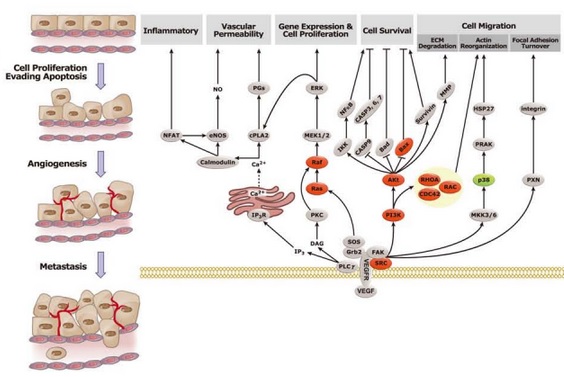Nuclear autophagy delays aging and preserves germline immortality
Loss of proteostasis is one of the characteristics of aging. Various stresses cause protein unfolding, which leads to protein aggregation and loss of proteostasis. When protein unfolding occurs, it is removed by the ubiquitin-proteasome or autophagic pathways, so that the proteostasis is maintained. Like this, autophagy and aging are closely related, and this fact attracts many researchers’ attention. In this blog, we introduce you to an interesting report that the nuclear protein autophagy (nucleophagy) is an important factor of aging and fertility of the nematode Caenorhabditis elegans and mice.
Autophagy modulates nuclear architecture via ANC-1/nesprin-2
Papandreou ME, et al. focused on the nuclear membrane anchor protein ANC-1 of nematode C. elegans and investigated whether ANC-1 regulates age-related changes in nuclear morphology. Consequently, they observed significant nuclear hypertrophy, morphological abnormalities, and accumulation of lamin-1 without ANC-1. Similarly, in mouse cells (MEF cells), inhibition of autophagy (bafilomycin A1 treatment) resulted in lamin B accumulation. In addition, when autophagy is inhibited in MEF cells and nesprin-2 (spectrin-repeat protein) is depleted, lamin B accumulation is also observed outside the nucleus. This finding implies that the autophagic degradation of lamin B is partially regulated by nesprin-2. The accumulation of lamins in nesprin-deficient C. elegans and mouse cells indicates that nesprin family members are evolutionarily conserved from C. elegans to mammals. Next, the authors confirmed that nesprin family members are selectively associated with nuclear autophagy. When autophagy was inhibited in C. elegans by RNA interference or other methods, ANC-1 accumulation was observed whereas depletion of ANC-1 in C. elegans resulted in the failure of the proper autophagy progression. Similarly, the results of autophagy inhibition in MEF cells also showed that nesprn-2 is degraded via autophagy, suggesting that the amount of nesprin-2 is regulated by autophagy. Also in mouse cells, like nematode’s case, depletion of nesprin-2 resulted in failure of autophagy progression. In addition to this, p62 protein in mouse cells, which leads to organelle-selective autophagy, was aggregated in the nucleus. These results suggest a link between organelle-selective autophagy involving the nucleus and nesprin family members. Past studies of various organisms, from nematodes to humans have reported that the size of the nucleolus is an important factor to drive their longevity if the low insulin/IGF-1 signaling and dietary restriction are given. However, the mechanisms that regulate the size of nucleolus size is still unknown. Therefore, the authors investigated how nesprin-mediated autophagy affects the nucleolus. As a result, they observed the nucleolus enlargement due to nesprin-2 depletion and ANC-1 depletion. This result shows that ANC-1/nesprin-2 affects the morphology of the nucleolus.
ANC-1/nesprin-2 promotes longevity
When they further investigated the expression of ANC-1 in the gonads of C. elegans, they found out that it partially localize to the nucleolus protein FIB-1. And when they suppressed the ANC-1 expression, it increased the size of the nucleolus in the germ cell. What is more, ANC-1- or autophagy-deficient nematodes had collapsed gonads and reduced egg-laying ability after 5 generations. So, they investigated the relationship between ANC-1 and lifespan. What they did here is to knocked down ANC-1 of the nematode C. elegans, having knocked down aging-related factor DAF-2. The DAF-2 knocked down nematode has longer longevity, but by knocking down the ANC-1, consequently, its lifespan became shortened. Thus, ANC-1 maintains nucleolus homeostasis and prolongs lifespan in C. elegans that were subjected to low insulin conditions by DAF-2 knockdown.

ANC-1/nesprin-2 contributes to the maintenance of germ cells
These findings suggest that nucleophagy is an important intracellular process that maintains the nuclear structure, regulates the size of the nuclear, and eventually promotes longevity. In particular, their results suggest that nesprin is required to maintain small nucleoli, one of the hallmarks of longevity. In addition, this study showed that ANC-1 lesions in C. elegans caused germline mortality. This fact also reminds us that the nesprin-2 polymorphism is associated with infertility and endometriosis in humans, indicating that ANC-1/nesprin-2 contributes to the maintenance of germ cells.
What next?
This report suggests that promoting nucleophagy may help maintain youth and longevity not only in C. elegans, but also in mammals. How to activate the nucleophagy will be one of the interesting topics to be discussed in the future.
References
- Papandreou, ME., Konstantinidis, G. & Tavernarakis, N. Nucleophagy delays aging and preserves germline immortality. Nat. Aging, 3, 34–46 (2023).
- López-Otín C, Blasco MA, Partridge L, Serrano, Kroemer G. The Hallmarks of Aging, Cell, 153, 6, 1194-1217 (2013).
Acknowledgment
Special thanks to Mr. Katsuya Noguchi (Senior Researcher), our partner from Dojindo Laboratories, for writing this article.
Keen to study autophagy?
Access easy & ready-to-use tools to detect autophagy in live cells, non-cytotoxic, no gene transfection needed, and enabling the autophagosome & autolysosome’s detection.



